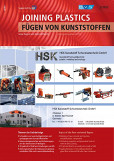Dimensioning and optimisation of directly screwed joints between parts which are made of ABS and are 3D-printed in the FDM procedure
Authors: Prof. Dr.-Ing. Elmar Moritzer, M. Sc. Johannes Hillemeyer, M. Sc. Christian Held
Additive manufacturing is a widespread standard in prototype construction in particular and is characterised by high degrees of design-related freedom and flexibility. Disadvantages are to be found in the long manufacturing times and the overproportional ratio of the costs to the construction space size. Direct screwing can be used for the economically sensible combination of additively manufactured plastic components with other components (even those made of other materials) in order to create larger products. Unlike injection-moulded components, there are no guidelines for the direct screwing of additively manufactured components. Against this background, initial preliminary investigations are being conducted with regard to the suitability of additive manufacturing for direct screwing. The investigation shows that the recommendations from injection moulding are not directly transferable. However, the design-related freedom of additive manufacturing offers a high potential for optimising the joint.
An active subscription enables you to download articles or entire issues as PDF-files. If you already are a subscriber, please login. More information about the subscription















